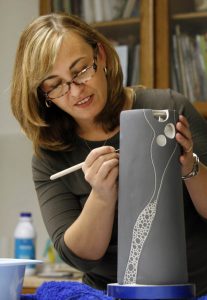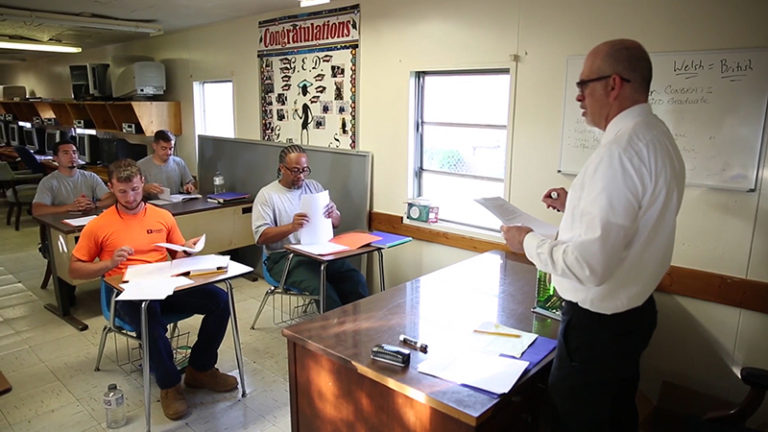 In 2018, FRANK Gallery moved from its original location on Franklin Street in Chapel Hill to a suite in the University Place Mall, just up the road. As FRANK Board Chair Sasha Bakaric points out, many people were initially “skeptical about showing fine art in such a commercial space, right between a gym and a fast food place.” But, as it turns out, the change in venue has been overwhelmingly positive. One of the biggest differences, according to Bakaric and other artists who work and volunteer at the gallery, is that in its current mall location, FRANK no longer has any doors—its brightly lit, highly curated interior is thrown open for all to ogle on their way to Planet Fitness, or as they amble past with a chicken sandwich from Chick-Fil-A. Integrated into a more trafficked, more accessible environment, FRANK Gallery is even better able to fulfill one of the central aspects of its mandate: to serve as an anchor for public arts in the Chapel Hill community.
In 2018, FRANK Gallery moved from its original location on Franklin Street in Chapel Hill to a suite in the University Place Mall, just up the road. As FRANK Board Chair Sasha Bakaric points out, many people were initially “skeptical about showing fine art in such a commercial space, right between a gym and a fast food place.” But, as it turns out, the change in venue has been overwhelmingly positive. One of the biggest differences, according to Bakaric and other artists who work and volunteer at the gallery, is that in its current mall location, FRANK no longer has any doors—its brightly lit, highly curated interior is thrown open for all to ogle on their way to Planet Fitness, or as they amble past with a chicken sandwich from Chick-Fil-A. Integrated into a more trafficked, more accessible environment, FRANK Gallery is even better able to fulfill one of the central aspects of its mandate: to serve as an anchor for public arts in the Chapel Hill community.
Bakaric, a ceramics artist who grew up in Croatia, told me in a conversation at the gallery that FRANK is a unique venture: unlike most artists’ collectives, the organization was formed in 2010 with a strong public-facing mission. Some co-ops are more impersonal, granting their artists a few feet of wall-space in exchange for the usual fee—a practice that can result in an insular, jumbled assortment in a disconnected gallery. At FRANK, by contrast, artists who participate in the co-op not only volunteer their time to help facilitate some of the organization’s many community events, but also regularly rotate out of the line-up, in order to facilitate a more cohesive, thoughtfully planned exhibition space.
FRANK gallery benefits two publics. The first is a local community, made up of Orange County residents. The second, importantly, is a strong community of county and regional artists. Serving both, this welcoming gallery makes fine art accessible to all while fostering a vibrant local arts scene.
For people who are not familiar with FRANK Gallery, can you talk about its role within the community? Can you describe some of FRANK’s community-oriented efforts? What is your specific role in these efforts?
FRANK was established as an artists’ collective almost ten years ago on Franklin Street with a mission to enrich downtown Chapel Hill through the arts. Since that time, we have moved to University Place and changed our mission to better reflect the reality of what we are doing. Our mission now: FRANK is a contemporary fine arts gallery, featuring work by local artists and enriching our community through exhibitions, events, and arts education. Sadly, there are very few exhibiting spaces in our community. Our visitors, both local as well as from out-of-town, very much appreciate that we show the work of artists from Orange County and surrounding areas. In addition to exhibiting work of our members and guest artists, we serve the community through various events like artists’ talks, salons, and educational workshops. We recently started “Coffee and donuts with FRANK” every first Saturday of the month, from 10-11 am. Our estimate is that about 13,000 people visited the gallery in 2018, both to see work exhibited in the gallery and to attend various events.
A very important segment of our activities is community outreach. One very long term project that we are very proud of is our work with Karen students. Orange County is home to a rather large Karen (Burmese) refugee community. FRANK’s Karen Youth Art group has been active since 2013. Several FRANK artists meet every Sunday morning teaching the young students different art techniques, taking them on educational field trips. In 2016 students wrote, illustrated and published a children’s book telling a story of their farming traditions.
FRANK has been given access to an additional space in the mall which we turned into a community gallery where we host guest professional artists groups and other arts-related exhibitions. In 2018-19 the exhibits in the Outreach Program/Gallery included Durham Academy’s “Heroes Book”; FRANK in FOCUS – CLICK! Photography Festival, in collaboration with Duke Center for Documentary Studies; Nancy Smith’s “Women Speak”; the Chapel Hill PTA Reflections Show; the Karen Youth Art Group Show and the Orange County Artists Guild (OCAG) Studio Tour Showcase Exhibit, their Holiday Show and their Spring Show.
FRANK is an artists’ collective. We currently have 22 member artists who are in charge of curating and hanging shows, inviting guest artists, organizing and hosting events and numerous other tasks of running a non-profit organization. FRANK has an active Board that consists of community business people and experts in various areas. I have been involved as a FRANK member artist since we first opened in 2010. In addition to my engagement as a member artist, I am currently the chair of the Board which means I am involved in almost every aspect of the gallery.
Why is it important to have artists represented in a community of non-artists? How do the arts contribute to the “public good”? More specifically, how do the visiting artists or artists on display in FRANK enrich our local public?
Art is a crucial segment of human existence and experience. Artists are fully aware of this, but it is harder to prove and persuade the broader public why and how important it is for everyone to have access to the arts. Art broadens our views of the world and teaches us compassion and understanding. It is especially important to bring arts to a population that doesn’t have access to it through their families or communities. When FRANK moved to the University Place Mall, many were skeptical about showing fine art in such a commercial space, right between a gym and a fast food place. It turns out that we are now in a perfect location where people who would never go to a gallery are walking in, engaging in conversations about art or listening to an artist talk about their work. FRANK also exhibits work of high-end craft. In today’s highly automated, industrial world, hand-made, unique objects are getting more attention and recognition.
What is one thing you wish that more people understood about helping direct, organize, and curate a gallery?
There is a general misconception that artists are not organized or incapable of running a business. I have worked in finance and management and it is my experience that most artists are extremely hard-working, more organized, and easier to work with than many in corporate environments. I wish there was more appreciation and recognition for the arts in general. It’s a legitimate business that brings tax dollars to our community and is of value to the broader public.
In your own artistic practice, you are inspired by images of microorganisms like bacteria and viruses. These are “communicable” organisms; they pass from person to person. Your artist’s statement says you dwell on these forms because you are interested in “questioning our relationship with the world inside us,” but have you also considered the social, interpersonal, or communicable dimensions of microorganic life? Do questions of human interrelation and communication enter into your artistic practice?
My relationship with the microscopic world is not something that I intentionally created. It started with a casual comment that the images that I was putting on my pieces looked like amebae. That prompted me to start looking into that world of microscopic organisms and cell structures. I was fascinated by the beauty of the images but also intrigued by dual emotions that most of us have when we see an image of a deadly but beautiful virus. When my mother was diagnosed with the same type of cancer that took my father, putting cells on my work got an extra meaning. In a way, I was trying to find peace with a cruel and beautiful nature that took both my parents. I am not necessarily thinking about conscious human interrelation that leads to the spread of viruses or bacteria. I am more interested in the interrelation of humans and the world that we don’t see, that we are not even aware of, or maybe in all the bacteria and viruses that live in and on us. We carry and support this often visually beautiful and sometimes deadly life.
To learn more about FRANK gallery and its public events, including artists’ talks, workshops, and educational series, visit https://www.frankisart.com/. Bakaric’s art can be found online at https://www.sashaceramics.com.





